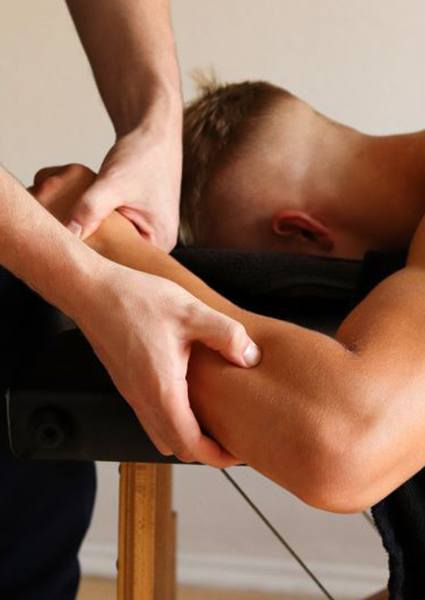Myofascial Release – Hollywood, FL
Gentle Treatment for Persistent Muscle Pain
Are you among the millions of people across the United States who struggle with persistent muscle pain, back pain, and similar symptoms? Here at the Institute for Non-Surgical Orthopedics in Hollywood, FL, our team wants to help you find lasting relief. One therapy that we might suggest is myofascial release, which is a form of osteopathic manipulative treatment (OMT). Continue reading this page to learn more about myofascial release and how this gentle treatment may be able to benefit you.
Why Choose the Institute for Non-Surgical Orthopedics for Myofascial Release?
- Treatment Performed by Highly Qualified Professionals
- Pain Relief Plans Customized for Each Patient
- Suitable for a Range of Conditions
What Is Myofascial Release?

Myofascial release falls under the umbrella of osteopathic manipulative treatment (OMT). However, unlike other forms of OMT, myofascial release is sometimes performed by care providers who are not osteopathic physicians. For that reason, it is sometimes classified as a form of therapeutic massage.
The purpose of myofascial release is to treat the myofascial tissues, which surround and support muscles throughout the body. These tissues have places called trigger points, which are extremely sensitive and can cause significant discomfort and pain when they are too tense. During myofascial release treatment, trigger points are carefully massaged with the goal of reducing tension and providing pain-free muscle movements.
What Problems Can Myofascial Release Treat?

Myofascial release can be a suitable way to address a range of conditions that affect muscular function. It is most commonly used to treat the symptoms of myofascial pain syndrome, which develops when a stimulus, such as an injury, causes tightness and tension in the muscles.
Myofascial release may also be recommended for individuals who are dealing with sports injuries, overuse injuries, and other conditions that are associated with painful trigger points.
If you are unsure of whether myofascial release could benefit you, book a consultation with our team. We may incorporate this therapy as one part of an integrative treatment plan that aims to help you enjoy pain-free movement.
What to Expect During Myofascial Release

When you hear the word “massage,” you might envision an intensely relaxing experience. However, it is important to remember that some forms of therapeutic massage cause temporary discomfort. Although practitioners try to be gentle, they must sometimes apply strong, continuous pressure to trigger points in order to help them relax. Therefore, while your overall experience with myofascial release should feel good, there may be some moments of mild pain.
It is also worth noting that trigger points are sometimes responsible for referred pain. In other words, they can cause pain in other parts of the body. It might take some time to find the exact trigger points that are bothering you.
It is common for a myofascial release session to last 30 – 60 minutes. You may be somewhat sore afterward. Some people also experience mild lightheadedness and nausea. It would be best to clear your schedule so you can rest after your appointment.
Most patients must visit us multiple times before they experience optimum benefits from myofascial release.
Myofascial Release FAQs

Want to know more about myofascial release (MFR) so you can get a better idea of whether the treatment is right for you? We’ve gone ahead and answered some of the most common questions we receive about it below. After you’ve read them over, if there is something else you would like to ask, don’t hesitate to get in touch with our office.
What Types of Pain Can Myofascial Release Address?
Because the fascia is found all over the body, fascia-related problems can be very widespread —appearing in the neck, back, feet, and anywhere in between. As such, myofascial release can help relieve pain across many areas.
What Does the Treatment Feel Like?
Myofascial release uses many of the same techniques as osteopathic manipulation, but instead of treating the muscles, ligaments, or tendons, it’s focused on the thin tissue just below the skin. As such, the motions and types of pressure applied aren’t meant to go as deep compared to other hands-on treatments. It can feel relaxing for some and a little painful for others as the doctor is trying to find and remove trigger points. While the process might be slightly uncomfortable in the moment, afterward, the body should feel looser and more flexible.
How Many Sessions Will I Need?
The number of MFR sessions a patient needs can differ based on the extent of their injury and desired recovery timeline. Some sessions might primarily revolve around the doctor trying to find the injured part of the fascia (as trigger points can be quite small), and then follow-up appointments will focus on treating it. At your first session, your doctor will evaluate you and be able to give you a general idea of how many treatments (and at what frequency) may be most beneficial for you.
How Long Does a Session Take?
A typical MFR session takes an hour or less, with the first one being a little longer because it will also involve a physical evaluation from your doctor as well as a conversation about your symptoms and goals. Individual sessions might start to get shorter as the issue is resolved, but this largely depends on how the body responds.
Is Myofascial Release Covered by Insurance?
Myofascial release is typically not covered by insurance, though we can help patients file claims to see if they can apply benefits. To help people afford it, we’re happy to go over their plans and also offer in-house financing if necessary.









